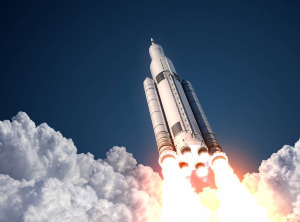
The space capsule was once the safest form of transportation. This was because the amount of money and expertise put into the United States’ space research made sure that the program was, statistically, safer than driving on a freeway during rush hour.
All of this changed on January 27, 1967, a day when Gus Grissom, Ed White, and Roger Chaffee reported for work at the Kennedy Space Center. As the three-man crew of the Apollo One spacecraft, they were to spend the day strapped in the cockpit of the command module, repeating over and over the lift-off drill they would use in a few weeks. After five hours of repeating the drill, a ground control technician noticed a malfunction. Immediately after, White’s voice was heard saying, “Fire in the cockpit.” The shocked controllers heard seven seconds of the crew trying to open the hatch, while Chaffee was begging, “We’re on fire...get us out of here.” The hatch was opened minutes later, but all three astronauts were dead. The oxygen-rich atmosphere of the cabin was ignited by a spark that most likely was the result of a loose wire. The National Aeronautics and Space Administration (NASA) chose the pure oxygen atmosphere over the safer oxygen and nitrogen mixture chosen by the Russians because it would mean that they would be able to use lighter and easy-to-use equipment. This choice was made even though some scientists warned the about fire hazards.
Four years later, on April 19, 1971, the Soviet Union’s permanent space station, Salyut One, was launched into orbit and was followed by the docking of the Soyuz Eleven capsule with three cosmonauts, or Russian astronauts. Soyuz Eleven was disengaged from the space station twenty-four days later and began its journey back to Earth. Even though radio contact was lost during re-entry, no one was worried. After Soyuz Eleven’s perfect landing, the recovery crew opened the hatch and found three dead men. They had suffocated after an air valve in the main hatch opened and, because their muscles had weakened due to prolonged weightlessness, they couldn’t close it again.
Almost fifteen years later, on January 28, 1986, another disaster took place. The objective of the Challenger 51L mission was to launch a tracking and relay satellite, and observe Halley’s comet as it reached the nearest point to the sun, an opportunity that wouldn't come again until 2062, 76 years later. The crew consisted of: vietnam veteran, test pilot, and commander of the crew Francis Scobee; Navy commander and pilot of the Space Shuttle Challenger Michael Smith; Air Force major Ellison Onizuka; electrical engineer and second American woman is space Judith Resnik; laser development specialist Ronald McNair; engineer Gregory Jarvis; and teacher Christa McAuliffe. Mrs. McAuliffe was a teacher and the first private citizen chosen to go to space. She was selected from 11,000 potential astronauts in NASA’s Teacher In Space project. Her sociable personality meant she could communicate what she learned to a young audience. She said she hoped to, “humanize the technology of the space age.” Her husband, parents, two children, and a group of her students were in the crowd of people who gathered to watch the launch. The mission had been postponed three times before and, that morning, some people still doubted it was wise to continue. Overnight, the temperature was below freezing and icicles were hanging around the launch pad. No shuttle had been launched in these temperatures before but the take off was scheduled for 11:38 a.m. Spectators watched as the Space Shuttle Challenger lifted off into a beautiful blue sky. Suddenly, at 11:39 a.m., the shuttle exploded into a huge fireball at a height of eight miles. It was the first time American astronauts were lost in a mission and the worst accident in 25 years of manned spaceflight.
As NASA teams were ordered to retrieve the debris from the Atlantic Ocean, President Ronald Reagan gave authority to former Secretary of State William Rogers to investigate what happened. This resulted in a 256 page report that incriminated NASA’s management because important engineering considerations had been ignored to maintain an ambitious program of launches every year. Some engineers had warned that the joints between the segments of the booster casings, sealed with two rubber O-rings, might fail under certain conditions, and this was exactly what happened to the Space Shuttle Challenger. The O-rings became fragile in the low temperatures and didn’t seal the joint properly. As the shuttle went faster and was hit by winds, the joints broke with destructive results. In the end, the shuttle shouldn't have been launched in those conditions.
Change in NASA’s management and modifications in the design followed, with a lesson that specialist engineers should be the ones who say whether a launch should happen or not. Like President Reagan said the night of the tragedy, “There will be more shuttle flights...more teachers in space. Nothing ends here. Our hope and our journeys continue.”
[Source:
The World's Greatest Disasters
]

